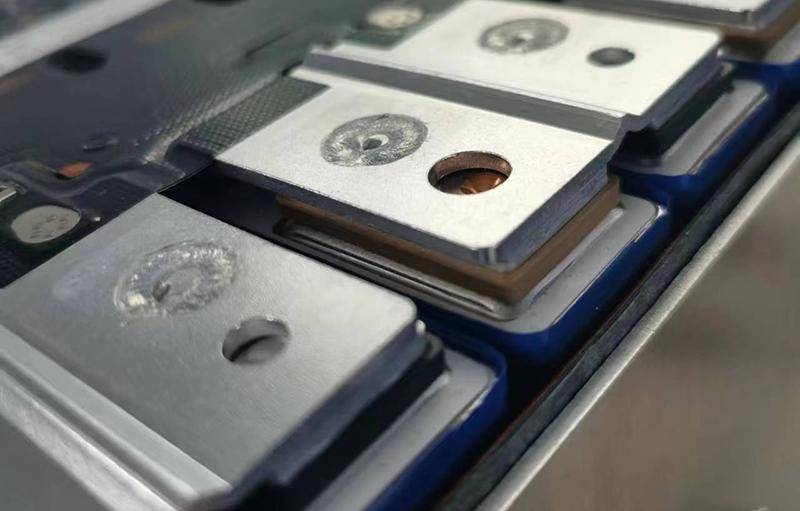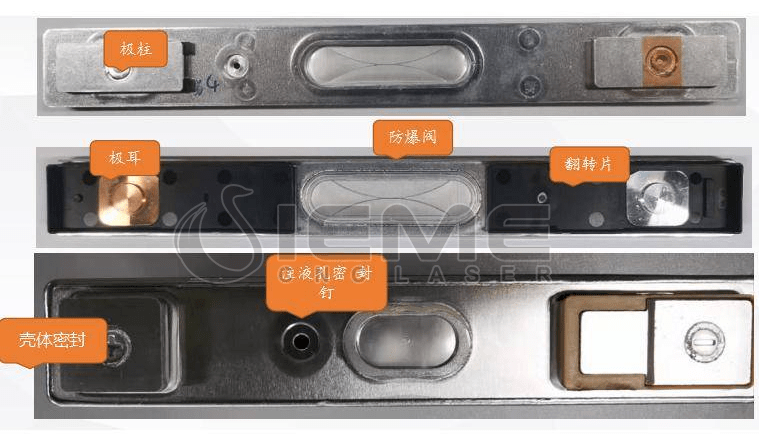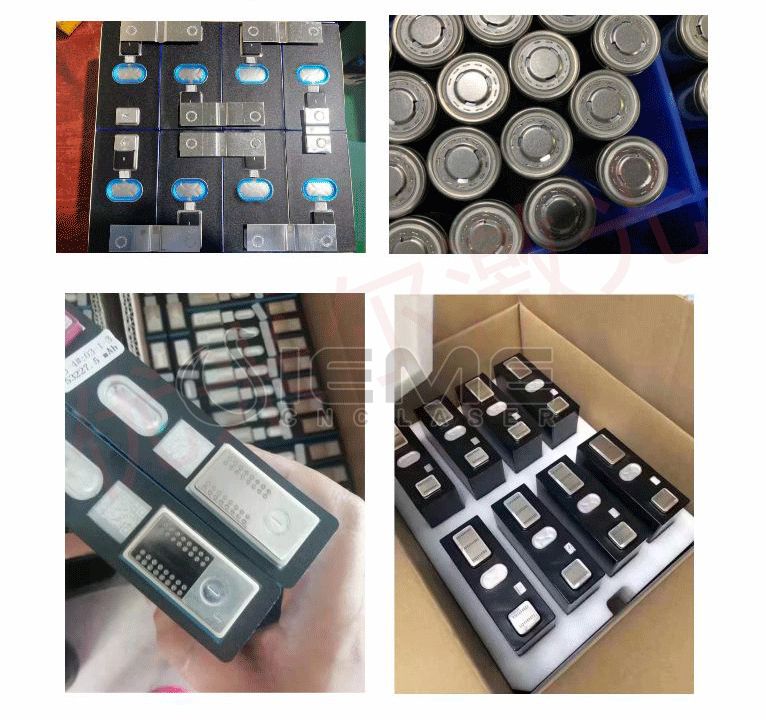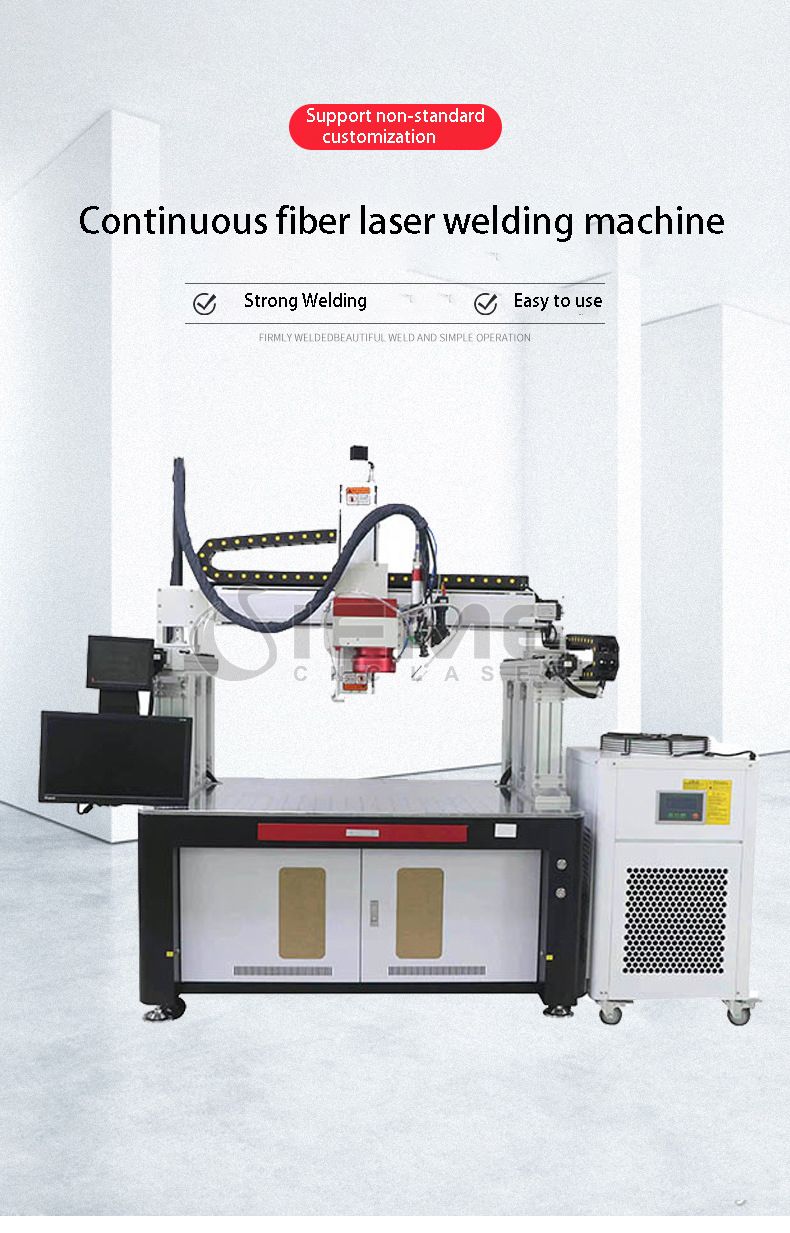The laser welding process technicians will select the appropriate laser and welding process parameters according to the customer's battery material, shape, thickness, tension requirements, etc., including welding speed, waveform, peak value, welding head tilt angle, etc. to set reasonable welding process parameters. Ensure that the final welding effect meets the requirements of power battery manufacturers. Due to its energy concentration, high welding efficiency, high processing precision, large weld seam depth-to-width ratio, and the laser beam is easy to focus, align and be guided by optical instruments, laser welding can be placed at an appropriate distance from the workpiece, in the Reguiding between fixtures or obstacles around the workpiece, etc., has outstanding advantages over ordinary welding methods. It is being increasingly used in the manufacture of power batteries and lightweight vehicles.

Laser welding machine for lithium ion pack principle
Laser welding uses the excellent directivity and high power density of the laser beam to work. The laser beam is focused on a small area through the optical system, and a heat source with highly concentrated energy is formed on the welded part in a very short time. zone, so that the solder is melted and forms a firm solder joint and weld.
1) Pulse mode welding
When laser welding, the appropriate welding waveform should be selected. The commonly used pulse waveforms are square wave, spike wave, double peak wave, etc. The reflectivity of the aluminum alloy surface is too high. When the high-intensity laser beam hits the material surface, the metal surface will be damaged. 60%-98% of the laser energy is lost due to reflection, and the reflectivity varies with surface temperature. Generally, when welding aluminum alloys, it is best to choose a sharp wave and a double peak wave. The pulse width of the slow-down part behind this welding waveform is longer, which can effectively reduce the generation of pores and cracks.
Due to the high reflectivity of the aluminum alloy to the laser, in order to prevent the vertical reflection caused by the vertical incidence of the laser beam and damage the laser focusing mirror, the welding head is usually deflected by a certain angle during the welding process. The diameter of the welding spot and the diameter of the effective joint surface increase with the increase of the laser inclination angle. When the laser inclination angle is 40°, the largest solder joint and effective joint surface are obtained. The weld penetration and effective penetration decrease with the laser inclination angle, and when it is greater than 60°, the effective welding penetration drops to zero. Therefore, tilting the welding head to a certain angle can appropriately increase the penetration depth and width of the weld.
In addition, when welding, with the weld seam as the boundary, it is necessary to weld 65% of the laser welding spot on the cover plate and 35% of the shell, which can effectively reduce the explosion caused by the problem of lid closure.
2) Continuous mode laser welding machine
Since the continuous laser welding is not like the sudden cooling and sudden heating of the pulse machine, the crack tendency is not obvious during welding. In order to improve the quality of the weld, continuous laser welding is used. The surface of the weld is smooth and uniform, no spatter, no defects, and the inside of the weld No cracks were found. In the welding of aluminum alloys, the advantages of continuous lasers are obvious. Compared with traditional welding methods, the production efficiency is high, and no wire filling is required; compared with pulsed laser welding, it can solve the defects after welding, such as cracks, Pores, splashes, etc., ensure that the aluminum alloy has good mechanical properties after welding; it will not be sunken after welding, and the amount of polishing and grinding after welding will be reduced, saving production costs. However, because the spot of the continuous laser is relatively small, the assembly accuracy of the workpiece Higher requirements.
In the laser welding of power batteries, the welding process technicians will select the appropriate laser and welding process parameters according to the customer's battery material, shape, thickness, tension requirements, etc., including welding speed, waveform, peak value, welding head tilt angle, etc. to set reasonable Welding process parameters to ensure that the final welding effect meets the requirements of power battery manufacturers.
Application of laser welding for connection sheet of power battery module:
The connection method between the power battery cell unit and the module busbar not only affects the manufacturing efficiency of the power battery, but also determines whether the production of the power battery can be automated. It also affects the performance of the power battery module after assembly. Neglected impact. Compared with the traditional welding method, laser welding has high efficiency and is easy to realize automatic production. After continuously improving the welding process and limiting the heat impact during the forming process, it has been applied more and more in actual production. Laser welding combined with industrial robots is gradually becoming the main force of the automated power battery module production line.
The laser welding process has become an important process in the manufacture of lithium batteries. Laser welding is the only non-contact, high-precision, and efficient welding method; it can economically and quickly weld and seal battery structural parts. Laser automatic welding process: manual loading → start button → cylinder feeding to the welding position → X, Y axis moves to the visual starting point → complete a plate of material vision, laser soldering → X, Y, Z axis reset, cylinder reset → remove Device → next cylinder feeding welding cycle.

Application of square shell lithium-ion battery sealing welding:
Lithium-ion power batteries have broad application prospects in the electric vehicle industry. During the manufacturing process of lithium-ion batteries, the consistency of aluminum shell welding quality greatly affects the consistency and safety of battery packs and PACK assembly systems. Therefore, The welding technology of battery aluminum shell has become a hot spot in current research.
Aluminum shell welding usually adopts laser welding process. Laser welding is to shoot a high-energy-density laser beam onto the vibrating mirror in a pulsed or continuous manner. By controlling the reflection angle of the mirror, the laser beam is caused to deflect and move. After focusing It is an efficient and precise welding method to radiate to the surface of the workpiece and use the generated heat to melt the aluminum materials on both sides of the weld seam of the workpiece to achieve the purpose of sealing welding under a specific strength.
Liquid injection hole sealing welding is generally referred to as PIN welding for short. It is to seal the battery after the opening is formed with a glue nail, and cover the glue nail with an aluminum PIN, and then weld the PIN on the battery cover for sealing. Through this process, the inside of the battery cell It is completely sealed. The quality of soldering PIN is related to the sealing degree of the battery. Poor soldering PIN will lead to battery leakage, lithium analysis, and poor appearance of the battery.

Power battery tab laser welding application:
Battery tabs are usually divided into three materials. The positive electrode of the battery uses aluminum (Al) material, and the negative electrode uses nickel (Ni) material or nickel-plated copper (Ni-Cu) material. In the manufacturing process of power batteries, one of the links is to weld the battery tabs and poles together. In the production of the secondary battery, it needs to be welded together with another aluminum safety valve. Welding not only needs to ensure reliable connection between tabs and poles, but also requires smooth and beautiful welds.
Lithium battery cap and tab ear laser welding machine For the popular rectangular cross-section mobile phone batteries, the sealing method is generally to have a rectangular cover plate on the top of the battery, with a positive lead-in end on the plate, and insert the cover plate into the shell to be flush with the mouth , and then weld and seal the rectangular gap between the cover plate and the shell. The laser has high brightness, good directionality, and good monochromaticity. Using it to weld the seal of the lithium battery case not only has minimal thermal deformation, direct and simple, neat and beautiful weld seams, but also is easy to cooperate with computer numerical control systems or manipulators to realize automatic welding. ,high productivity.
Advantages of laser welding machine for lithium ion battery
Concentrated energy, high welding efficiency, high processing precision, and large weld depth-to-width ratio. The laser beam is easy to focus, align and be guided by optical instruments. It can be placed at an appropriate distance from the workpiece, and can be redirected between fixtures or obstacles around the workpiece. Other welding methods cannot be used due to the above-mentioned space constraints.
The heat input is small, the heat-affected zone is small, the residual stress and deformation of the workpiece are small; the welding energy can be precisely controlled, the welding effect is stable, and the welding appearance is good;
Non-contact welding, optical fiber transmission, good accessibility and high degree of automation. When welding thin materials or thin wires, there is no problem of melting back like arc welding. The battery cells used for power batteries follow the principle of "lightness", and usually use "lighter" aluminum materials, but also need to be made "thinner". Generally, the shell, cover, and bottom are basically required to be less than 1.0 mm. At present, the thickness of basic materials of mainstream manufacturers is about 0.8 mm.
It can provide high-strength welding for various material combinations, especially when welding between copper materials and aluminum materials. It is also the only technique that can weld electroplated nickel to copper.
Difficulties in laser welding process
At present, the battery case made of aluminum alloy accounts for more than 90% of the entire power battery. The difficulty of welding is that the reflectivity of aluminum alloy to laser is extremely high, the sensitivity of porosity is high during welding, and some problems and defects will inevitably appear during welding, the most important of which are porosity, thermal cracks and fire.
Pores are prone to occur during the laser welding process of aluminum alloys. There are two main types: hydrogen pores and pores caused by bubble collapse. Because the cooling rate of laser welding is too fast, the problem of hydrogen holes is more serious, and there is an additional type of holes caused by the collapse of small holes in laser welding.
Hot crack problem. Aluminum alloys are typical eutectic alloys. Hot cracks are prone to occur during welding, including weld crystal cracks and HAZ liquefaction cracks. Due to the composition segregation of the weld zone, eutectic segregation will occur and grain boundary melting will occur. Liquefaction cracks form at the grain boundaries, reducing the performance of the welded joint.
Explosion fire (also known as splash) problem. There are many factors that cause an explosion, such as the cleanliness of the material, the purity of the material itself, the characteristics of the material itself, etc., but the stability of the laser is the decisive factor. Shell surface protrusions, air holes, internal air bubbles. The reason is that the fiber core diameter is too small or the laser energy setting is too high. It’s not that “the better the beam quality, the better the welding effect” advertised by some laser equipment providers, good beam quality is suitable for overlay welding with larger penetration depth. Finding the right process parameters is the magic weapon to solve the problem.
other difficulties for welding lithium ion battery
Welding of soft-packed tabs has high requirements for welding equipment, and the tabs must be pressed firmly to ensure the welding gap. It can realize high-speed welding of complex trajectories such as S shape and spiral shape, increase the joint area of weld seam and strengthen welding strength at the same time.
The welding of cylindrical batteries is mainly used for the welding of the positive electrode. Since the shell of the negative electrode is thin, it is very easy to weld through. For example, some manufacturers currently use the negative electrode welding-free process, and the positive electrode uses laser welding.
When welding the combination of square batteries, the poles or connecting pieces are polluted and thick. When welding the connecting pieces, the pollutants decompose, which is easy to form welding explosion spots and holes; batteries with thin poles and plastic or ceramic structural parts are easy to weld. wear. When the pole is small, it is also easy to be welded to the point where the plastic burns, forming a burst point. Do not use multi-layer connection sheets, there are holes between layers, and it is not easy to weld firmly.
The most important process of the welding process of the square battery is the packaging of the case cover, which is divided into welding of the top cover and the bottom cover according to the position. Some battery manufacturers use the "deep drawing" process to manufacture the battery case due to the small size of the battery produced, and only need to weld the top cover.
The welding methods of prismatic batteries are mainly divided into side welding and top welding. The main advantage of side welding is that it has less impact on the inside of the battery cell, and spatter will not easily enter the inside of the case cover. Since the bulge may be caused after welding, which will slightly affect the assembly of the subsequent process, the side welding process has extremely high requirements on the stability of the laser and the cleanliness of the material. As the top welding process is welded on one surface, the requirements for the integration of welding equipment are relatively low, and mass production is simple, but there are also two disadvantages. One is that a little spatter may enter the battery core during welding, and the other is the front part of the shell. High processing requirements can lead to cost problems.
Influencing factors of Laser welding quality
Laser welding is currently the main method recommended for high-end battery welding. Laser welding is a process in which high-energy laser beams irradiate workpieces, causing the working temperature to rise sharply, and the workpieces are melted and reconnected to form a permanent connection. The shear strength and tear strength of laser welding are relatively good. The quality of battery welding, its conductivity, strength, air tightness, metal fatigue and corrosion resistance are typical welding quality evaluation criteria.
There are many factors that affect the quality of laser welding. Some of them are extremely volatile and have considerable instability. How to correctly set and control these parameters, so that they can be controlled within a suitable range during the high-speed continuous laser welding process, so as to ensure the welding quality. The reliability and stability of weld formation is an important issue related to the practicality and industrialization of laser welding technology. The main factors affecting the quality of laser welding are welding equipment, workpiece condition and process parameters.
1) Laser requirements
The most important quality requirements of laser welding equipment for lasers are beam mode, output power and stability. The beam mode is the main indicator of the beam quality. The lower the order of the beam mode, the better the beam focusing performance, the smaller the spot, the higher the power density at the same laser power, and the larger the depth and width of the weld. Generally, the basic mode (TEM00) or low-order mode is required, otherwise it is difficult to meet the requirements of high-quality laser welding. At present, domestic lasers still have certain difficulties in laser welding in terms of beam quality and power output stability. Judging from the foreign situation, the beam quality and output power stability of the laser are already quite high, which will not become a problem for laser welding. The most important factor affecting the welding quality in the optical system is the focusing lens. The focal length used is generally between 127mm (5in) and 200mm (7.9in). Contamination and splash damage in the process.
The shorter the wavelength, the higher the absorption rate. Generally, materials with good conductivity have high reflectivity. For YAG laser, the reflectivity of silver is 96%, that of aluminum is 92%, that of copper is 90%, and that of iron is 60%. The higher the temperature, the higher the absorption rate, which is a linear relationship; generally, the surface can be coated with phosphate, carbon black, graphite, etc. to increase the absorption rate.
2) Workpiece status
Laser welding requires the edge of the workpiece to be processed, assembled with high precision, and the light spot and weld seam to be strictly aligned, and the original assembly accuracy of the workpiece and the centering of the light spot cannot be changed due to welding thermal deformation during the welding process. This is because the laser spot is small and the weld seam is narrow, so filler metal is generally not added. If the assembly is not strict and the gap is too large, the beam can pass through the gap and cannot melt the base material, or cause obvious undercuts and depressions, such as the deviation of the spot to the seam Slightly larger may result in lack of fusion or incomplete penetration. Therefore, the general plate butt joint assembly gap and spot deviation should not be greater than 0.1mm, and the wrong side should not be greater than 0.2mm. In actual production, sometimes laser welding technology cannot be used because these requirements cannot be met. To obtain a good welding effect, the allowable butt joint gap and lap gap should be controlled within 10% of the thickness of the thin plate.
Successful laser welding requires intimate contact between the substrates being welded. This requires careful tightening of the parts for best results. This is difficult to do well on the thin tab substrate, which is prone to bending and misalignment, especially if the tab is embedded in a large battery module or assembly.
3) Welding parameters
(1) Influence on the laser welding mode and weld forming stability The most important welding parameter is the power density of the laser spot, which has the following effects on the welding mode and weld forming stability: as the laser spot power density changes from small to large The order is stable heat conduction welding, mode unstable welding and stable deep penetration welding. The power density of the laser spot is mainly determined by the laser power and the position of the beam focus when the beam mode and the focal length of the focusing mirror are fixed. The laser power density is directly proportional to the laser power. The influence of the focus position has an optimal value; when the beam focus is at a certain position under the surface of the workpiece (within the range of 1-2mm, depending on the plate thickness and parameters), the most ideal weld can be obtained. Deviating from this best focus position, the spot on the workpiece surface will become larger, causing the power density to decrease, and to a certain range, it will cause changes in the form of the welding process.
The influence of welding speed on the form of welding process and stable parts is not as significant as that of laser power and focus position. Only when the welding speed is too high, the stable deep penetration welding process cannot be maintained due to the small heat input. In actual welding, stable deep penetration welding or stable heat conduction welding should be selected according to the requirements of the weldment for penetration, and mode unstable welding should be absolutely avoided.
(2) In the deep penetration welding range, the influence of welding parameters on the penetration depth: in the stable deep penetration welding range, the higher the laser power, the greater the penetration depth, which is about the relationship of 0.7 power; and the higher the welding speed change , the shallower the depth of fusion. Under the conditions of certain laser power and welding speed, the penetration depth is the largest when the focus is at the best position. If it deviates from this position, the penetration depth will decrease, and even become mode unstable welding or stable heat conduction welding.
(3) The influence of shielding gas.
The main function of shielding gas is to protect the workpiece from oxidation during welding; to protect the focusing lens from metal vapor pollution and sputtering of liquid droplets; to disperse plasma generated by high-power laser welding; to cool workpiece, reducing the heat-affected zone.
The protective gas is usually argon or helium, and nitrogen can also be used if the apparent quality is not high. Their tendency to generate plasma is significantly different: helium has a higher ionization potential and faster heat conduction, and under the same conditions, it has a lower tendency to generate plasma than argon, so a greater penetration depth can be obtained. Within a certain range, with the increase of the shielding gas flow rate, the tendency to suppress the plasma increases, so the penetration depth increases, but it tends to be stable when it increases to a certain range.
(4) Analysis of the monitorability of each parameter: Among the four welding parameters, welding speed and shielding gas flow rate are parameters that are easy to monitor and maintain stability, while laser power and focus position may fluctuate during the welding process and are difficult to monitor parameters. Although the laser power output from the laser has high stability and is easy to monitor, due to the loss of the light guide and focusing system, the laser power reaching the workpiece will change, and this loss is related to the quality, service time and surface contamination of the optical workpiece The situation is related, so it is not easy to monitor and become an uncertain factor of welding quality. The beam focus position is one of the welding parameters that has a great influence on the welding quality and is the most difficult to monitor and control. At present, in production, it is necessary to rely on manual adjustment and repeated process tests to determine the appropriate focus position in order to obtain the ideal penetration depth. However, during the welding process, due to workpiece deformation, thermal lens effect or multi-dimensional welding of space curves, the focus position will change and may exceed the allowable range.
For the above two situations, on the one hand, it is necessary to use high-quality, high-stability optical components and maintain them frequently to prevent pollution and keep them clean; on the other hand, it is required to develop real-time monitoring and control methods for the laser welding process to optimize parameters and monitor arrival The change of laser power and focus position of the workpiece realizes closed-loop control and improves the reliability and stability of laser welding quality.
Finally, note that laser welding is a melting process. This means that the two substrates will melt during the laser welding process. This process is quick, so the overall heat input is low. But because this is a melting process, brittle, high-resistance intermetallic compounds can form when welding dissimilar materials. Aluminum-copper combinations are particularly prone to intermetallic formation. These compounds have been shown to negatively impact the short-term electrical and long-term mechanical properties of microelectronic device bonding joints. The impact of these intermetallic compounds on the long-term performance of lithium batteries is uncertain.
